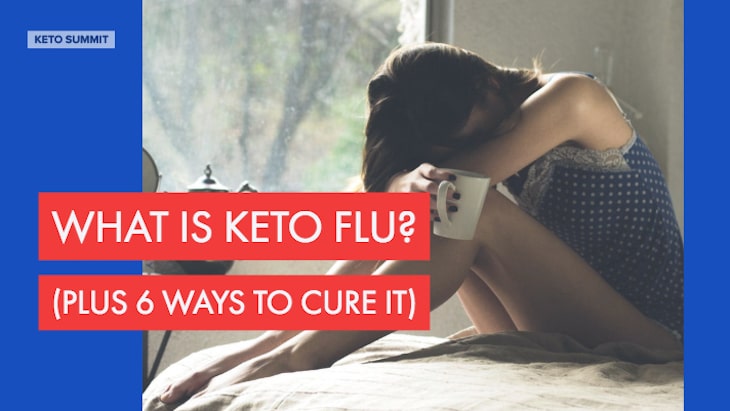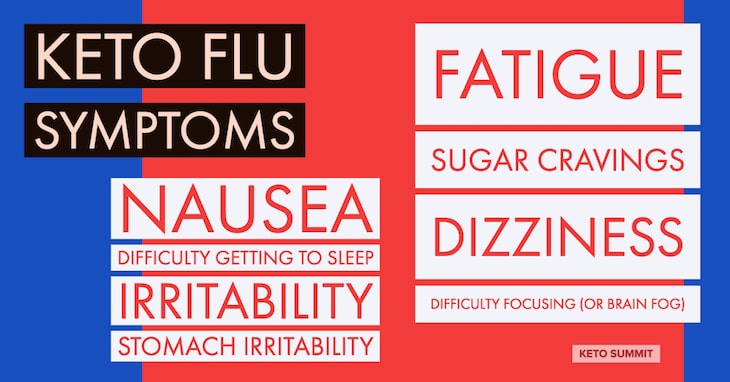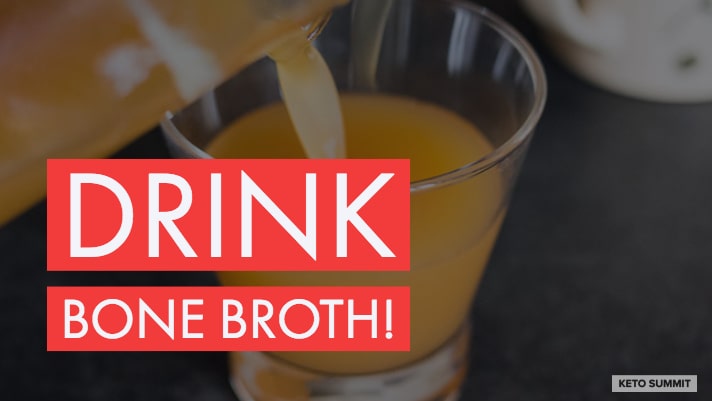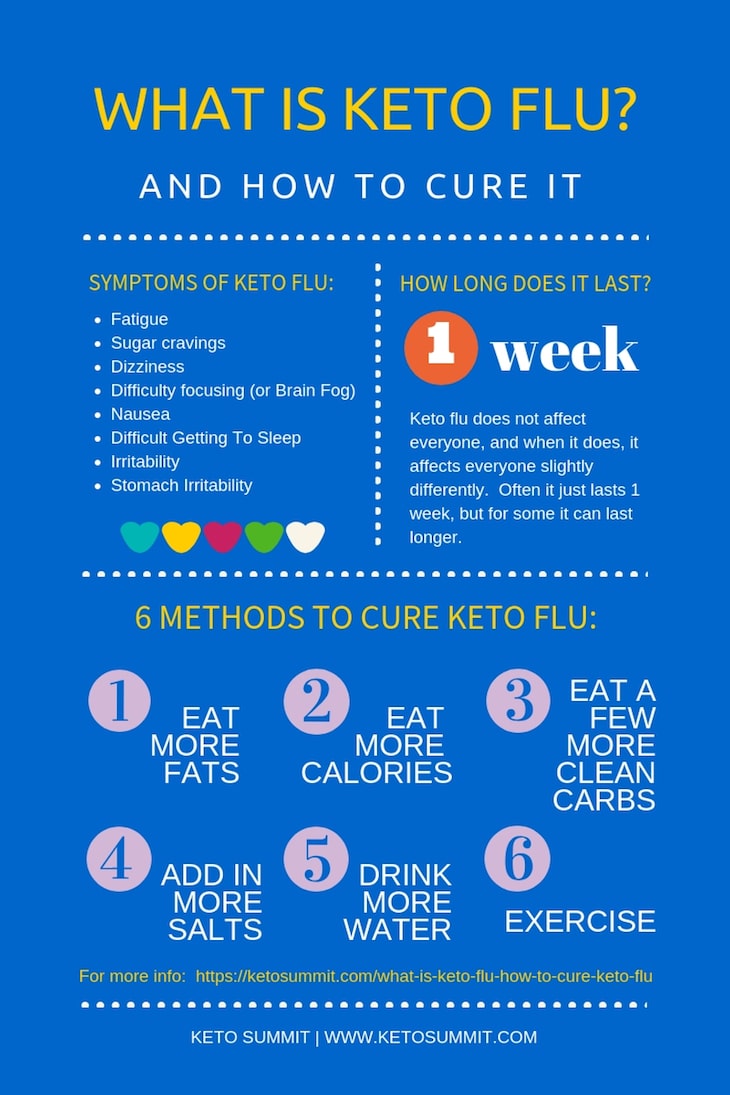What Is Keto Flu? (PLUS 6 Ways To Cure It)

You’re tired and dizzy, you crave sugar, bread, pasta, and your mind wanders like crazy. You just started a Keto diet, and you’re suspicious that cutting out the carbs is the culprit for making you feeling this crappy.
- So, what is Keto flu or carb flu?
- What are the Keto flu symptoms?
- How long does it last?
- What can you do to make Keto flu go away faster? Here are 6 ways.
- What about other Keto side effects?
- Keto Rash
- Keto Diarrhea
- Keto Constipation
- Keto Headache
We’ll address all of these and more in this article. In particular, skip down to the section how to cure Keto flu if you’re in a hurry!
WHAT IS KETO FLU?
Keto flu or carb flu describes the flu-like symptoms that people starting a low-carb, Paleo, or Ketogenic diet often experience.
Why does this happen for some people? There’s no definite answer, but if you feel bad when you first start a Keto diet, then it’s probably due to one of these 3 reasons:
- You’re not fat-adapted or metabolically flexible, so you don’t burn fat well.
- You’re low in electrolytes.
- Your body wants carbs!
If you’ve been eating a Standard American Diet (SAD) for a long time, then your body is used to eating over 200 grams of carbohydrates (often in the form of sugar) every day. And when you go Keto, you’re cutting that carb intake down to under 25 grams per day.
That means your body has to adjust. In particular, your body needs to stop relying on glucose for energy and switch instead to burning your fat stores. If you have been eating unhealthily for a long time, then your body is likely to be “metabolically inflexible”, meaning you can’t switch between those two sources of energy easily.
So, when you first start Keto, your body is unable to access your fat energy sources and instead keeps telling your brain that you need more sugar for energy. That then leaves you craving carbs and feeling weak.
(If you’re interested in the science behind metabolic flexibility, then this article provides a very detailed explanation.)
A different way to think about it is carb withdrawal. This article explains it as resulting from withdrawal from carbohydrates (think drug addiction here). And indeed, there are studies showing that sugars (which are a form of carbohydrates) can cause drug-like addictions.
So what are these carb withdrawal symptoms that you have to deal with?
KETO FLU SYMPTOMS
Symptoms can really vary from person to person. You might just feel a bit tired while your friend might get seriously moody and have stomach upsets.
Common Symptoms When You First Start Keto:
- Fatigue
- Sugar cravings
- Dizziness
- Difficulty focusing (or Brain Fog)
- Nausea
- Difficulty Getting To Sleep
- Irritability
- Stomach Irritability

HOW LONG DOES KETO FLU USUALLY LAST?
This is a tough one as it varies from person to person.
According to Dr. Andreas Eenfeldt, M.D., “Most people feel one or more of these symptoms during the first week of a keto diet, especially days 3-5. Fortunately, it’s temporary, and you’ll soon feel fine again. In fact, you’ll likely have more energy than before you started the diet.”
Generally, most people find the issues are worst in the first week of ditching carbs from their diet.
Some people will find symptoms linger into the second week. A few people report symptoms of feeling weak lasting 3-5 weeks.
It sounds rough, but don’t worry though…while Keto flu is inconvenient, it’s thankfully temporary.
As Registered Dietician Kristin Kirkpatrick, RD says: “At one point, during a heated discussion about dog food, [my husband] suggested, in a very loving and compassionate manner, that perhaps I eat a piece of bread. It was a rough start. And then, it wasn’t. The cloud lifted. I went from irritable and “hangry” to feeling great.”
So if you’re feeling under the weather, don’t panic. I’ve listed several ways below to shorten that period of feeling crappy below.
HOW TO CURE KETO FLU
Below are 6 methods for making you feel better quickly and effectively. And I’ll also suggest below a really easy way to incorporate many of these tips into one simple daily drink.
1. Eat More Fats
This is one of the common methods people use to combat the flu’s symptoms. Your body still needs energy and since it’s not getting its energy from sugars and other carbohydrates any more, it needs to get energy from fats you eat. (Click here to listen our podcast episode on regaining energy!)
So eat plenty of healthy fats like coconut oil, olive oil, ghee, tallow, lard. Plus, to go into ketosis, you’ll need to eat plenty of fats anyway. Adding some MCT oil to your diet can help boost your ketone levels, which will help your brain feel a bit better.
2. Eat More Calories
It’s easy to eat too little food in general when you first start Keto. Most people just eliminate the high carb foods from their previous diet without increasing the other food intake.
Many people are also confused about what they can eat when they have to ditch the carbs because they’re so used to filling their plates with pasta, rice, bread.
So, if you’re feeling down, try to eat more. Check out our low carb and ketogenic recipes here for ideas on what to eat. Or download our comprehensive Keto diet food list by clicking here.
3. Eat A Few More Clean Carbs (especially if you are active)
While cutting down your carb intake all at once may result in faster weight loss, the simple fact is you’re not going to lose any weight unless you stick to that low carb or Keto diet. So, your first priority should be to ensure you’re not going to give up on the diet because you feel too crappy. If that’s going to be the case, then try reducing your carb intake slowly.
4. Add More Salts To Your Diet
When you go low carb, your insulin levels will tend to go down, which in turn means you don’t hold on to as much sodium as before. You also get rid of excess water that you’ve been holding on to (hence why you’ll usually experience decreased bloating when you go low carb or Keto).
So, to combat this decrease in sodium, the simple answer is to take in a bit more salt as sodium deficiency is also a huge issue. If you’re afraid to eat too much salt, then rest assured that if you’re cutting out all the junk food, you’re already consuming way less salt than before (even bread contains salt so you were probably eating way way more sodium before).
5. Drink Enough Water
Dehydration can often give you a headache, nausea, and fatigue so make sure you also drink plenty of water during this period.
6. Exercise (If You Can)
Exercise may be the last thing on your mind right now as you woozily read this article. But studies have suggested that exercise can help you become more metabolically flexible. (Being metabolically flexible means that your body can switch between using carbs and ketones for energy more easily.)
Additionally, Dr. Tommy Wood, M.D., PhD. suggested during a Q&A session on the Keto Summit that supplementing with carnitine can help you gain metabolic flexibility. This is because it can help move the fatty acids to the mitochondria.
Registered Nurse Rachel Nall, RN, notes that once you get over the annoying Keto side effects, you’ll experience the full benefits of a ketogenic diet. “However,” she adds, “people must carefully watch their food intake to ensure they are getting enough calories and nutrients to support good health.”
BONUS: 2 Super Easy Ways to Get Rid Of Keto Flu
Over the years, I’ve found 2 supplements to really help with getting over carb withdrawal fast so you can enjoy the benefits of Keto with minimal pain!
1. Exogenous Ketones
There’s a lot of hype around exogenous ketones. And while they can’t burn off your fat for you, they can help ease you into ketosis with less Keto headaches and other symptoms. If you want to give them a try, then check out our post about exogenous ketones (the good and the bad) here. We recommend Keto Upgrade.
2. Bone Broth
Bone broth is nature’s perfect Keto drink! It’s filled with electrolytes, healthy fats, and of course water.
Now, if you read Keto forums, then many people suggest diluting a bouillon cube in water and drinking that to boost your electrolytes. But if you’ve ever looked at the ingredients in bouillon cubes, you’ll probably think twice about using them again (they read like a nutrition nightmare regardless of what diet you’re on)!
So, my suggestion is to make your own bone broth and add salt and spices to it.
Here’s a simple recipe you can follow for making bone broth in the slow cooker. And just keep the slow cooker going so you can have continuous access to bone broth.
If you’re averse to making bone broth, you can also purchase chicken broth (like this one) that has pretty clean ingredients or in many parts of the US, you can also purchase ready-made bone broth (check out this website for purchasing bone broth).

OTHER KETO SIDE EFFECTS
If you haven’t started Keto yet, then this post can sound rather off-putting! But honestly, these symptoms typically go away quickly (faster if you’re metabolically flexible and use the 6 methods I described above). And then you’ll be left to enjoy all the benefits of a Keto diet like fat-loss, more energy, less hunger, and more focus.
However, if you do find yourself experiencing some of the side effects of Keto, then make sure to consult your medical professional. Also note that not all side effects might be due to your dietary change!
Keto Rash
If you’ve recently begun a Ketogenic diet, and you are suddenly itchy – there is no need to panic. Yes, it is uncomfortable and annoying (and it likely will be for a few days), but you can prevent it from happening and it is treatable once it has begun.
Symptoms and Causes
No one really knows exactly what causes these rashes, but it usually appears as raised bumps on the skin that can be red, pink or brown. The rash typically appears in the armpits, stomach, shoulders chest, neck and back, though it can sometimes pop up on the face and extremities as well.
No two people will experience Keto rash in the same way either. For some people the rash will go away in a few days, in others it can linger for weeks or months.
As with all medical issues, always check with your medical practitioner! Don’t just read an article online about it 🙂
How To Treat Keto Rash
If you experience a rash when you start a Ketogenic or other low carb diet, there are a few things you can do to treat it:
1. Eat more carbs.
It might seem counterintuitive, but sometimes adding in more clean carbs can help. Choose healthy sources of carbs like sweet potatoes rather than processed sugars or wheat. And don’t stuff yourself with carbs – just add back a bit more carbs.
2. Check food allergens.
The Keto rash could be due to your body being sensitive to the new foods you’re eating.
For example, if you’ve started eating a lot more dairy, nuts, dairy, or even nightshades, then these common food allergens could be the cause of your rash. Try eliminating certain foods from your diet and see if your rash improves.
3. It might not be Keto!
It could be that your rash has nothing to do with your diet changes. Check whether it’s an allergy to a chemical or material you’ve come into contact with or an insect bite.
Preventing Keto Rash
If you’re worried that you’ll start itching when you cut your carbs, then just take it slowly. Decrease your carb intake slowly so that your body has time to get used to it.
Pay attention to how your body is reacting. Are you sensitive to certain foods like nuts or eggs? The sensitivity could present itself in ways other than a rash – so watch out for other changes in your body too.
Keto Constipation
Changes to what you regularly eat can often causes short-term stomach upsets. And constipation could be one of the side effects. Luckily, the suggestions below should give you some relief quickly.
Causes
One of the most common causes of constipation is not eating enough fiber. And that’s the case regardless of the diet you’re on.
However, when you first go Keto, you might be scared of eating any fruits or vegetables (because they contain carbs). And so your fiber intake decreases dramatically, thereby causing constipation.
How To Treat Keto Constipation
1. Add in more fiber.
Make sure to add in lots of Keto foods high in fiber. Celery, almond butter, flaxseed, almond flour, and coconut flour are all high in fiber and keto friendly. Psyllium husk is also useful and is a popular fiber supplement.
2. Add in Prebiotic Fibers and Probiotics.
Our guts are full of billions of good bacteria that allow us to live healthy lives. Among other things, these bacteria help to break down the foods we eat, produce fatty acids in our bodies and keep our immune systems robust.
These good bacteria thrive on prebiotic fibers, which you might not be getting enough of if you don’t eat enough Keto vegetables.
This can cause the bacteria to not be able to do their job digesting food, resulting in constipation.
To help boost your gut microbiome, make sure to supplement with a great comprehensive blend of Prebiotic Fibers (like CoBionic Foundation) and a good probiotic supplement.
3. Make sure to eat enough food.
Cutting out carbs and replacing them with satiating fats will almost always decrease the amount of food you are eating. You simply won’t be hungry enough to eat as much as you did before.
Not eating as much food can cause your digestion to slow down which in turn causes your bowels to slow down. The longer your stool is allowed to remain in your system, the more it dries out and the more constipated you can become.
You’ll want to help things along by boosting the bulk of your stool. You can eat more, but make sure it’s not mindless eating and be sure you are getting enough fiber from vegetables.
4. Drink plenty of water.
Be sure you are drinking enough water as well. You need to give your stool enough water to move through your digestive tract.
Keto Diarrhea
Diarrhea (and constipation) are sometimes considered carb flu symptoms as they often occur when you first start a Keto diet. But they can also occur whenever you change up your diet a lot.
Causes
In particular, adding more fats into your diet can often result in more frequent trips to the bathroom. When your fat intake increases, your liver starts producing more bile to break down the fat. Bile is necessary for the lubrication of your colon as well, and excess bile will allow for your stool to be easily excreted.
Another cause of Keto diarrhea is sensitivity to certain foods like dairy and nuts.
How To Treat Keto Diarrhea
1. Eat less fat.
If you’re unused to eating so much fat, then don’t eat too much all at once. Start slowly – drizzle some olive oil on your vegetables and eat fattier cuts of meat. But don’t just slather butter on top of everything!
2. Check food sensitivities.
Lactose intolerance is a common cause of stomach problems (from bloating and gas to diarrhea and constipation). Try eliminating foods like dairy and nuts from your Keto diet and see if that helps.
3. Add in Prebiotic Fibers and Probiotics.
The health of your gut bacteria controls your stomach issues! So making sure you have plenty of healthy gut bacteria is key. Make sure to take a comprehensive blend of Prebiotic Fibers (like CoBionic Foundation) as well as a good probiotic supplement.
4. Check your Keto supplements.
Many people take MCT oil and exogenous ketones when they start a Keto diet in order to boost their ketone levels. However, if you’re unused to taking these Keto supplements, then they can cause you to have the runs pretty badly. So make sure to start with a small amount at first (a few grams of ketone salts per day OR 1/2 teaspoon of MCT oil). And then gradually increase your intake as your stomach adjusts to it.
Keto Headache
Headaches are perhaps one of the most common side effects of Keto and it’s definitely a very common Keto flu symptom.
Causes
The main causes for these headaches are:
- Sugar and carb withdrawal
- Dehydration
- Electrolyte imbalance
Sugar has often been likened to a drug and can be just as addictive for some people. When you cut sugar out of your diet, your brain experiences withdrawal and this can create pain and headaches.
At the beginning of any diet that is lower in carbs, your body will rid itself of excess water and you will likely become dehydrated. Dehydration almost always leads to headaches as well.
Magnesium, potassium, and sodium are electrolytes that your body needs. When you become dehydrated, your body loses out on these necessary minerals and you experience headaches as a result.
Preventing And Treating Keto Headaches
Following the 6 methods I listed above for curing Keto flu will also get rid of your headach quickly.
In particular, make sure to increase your water intake and add electrolytes to your water. You can add a pinch of sea salt to your water to help this along, and you can also add more sea salt to your food to increase your sodium intake.
CONCLUSION
While the symptoms of carb flu are painful, they are worth it! Not only do most people experience weight loss after that initial period, they also find they have more energy, less bloating, fewer digestive issues, and a bunch more benefits.
But as I mentioned above, the diet only works if you stick to it. So if you find the symptoms unbearable, then try to introduce more clean carbs like sweet potatoes and other vegetables or some fruits.
And if you do give up or end up cheating on your diet, don’t despair! Just pick it back up again the next day. There’s no guilt – just your journey to better health.
INFOGRAPHIC – please pin!
Please feel free to pin and share this infographic.

